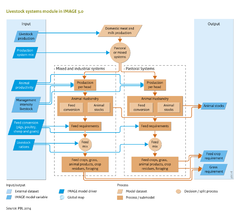Livestock systems/Description
Parts of Livestock systems/Description
| Component is implemented in: |
| Components: |
| Related IMAGE components |
| Projects/Applications |
|
| Models/Databases |
| Key publications |
| References |
Model description of Livestock systems
Livestock production
IMAGE distinguishes two livestock production systems for ruminants (i.e. beef, dairy cattle, sheep and goats), namely pastoral systems, and mixed and industrial systems, based on FAO (Seré and Steinfeld, 1996). Pastoral systems are mostly dominated by extensive ruminant production, while mixed and industrial systems are more intensive. The distribution of livestock production in the two systems is constructed from historical data for the years up to the present, and for future years will depend on the scenario selected.
For the main monogastric sectors pigs and poultry IMAGE distinguishes three livestock systems. For pigs these are backyard, intermediate and intensive systems, and for poultry these are backyard, broiler and laying hens systems (Lassaletta et al., 2019). Both models consists of four modules: production, herd, energy and nitrogen module.
Livestock
IMAGE distinguishes five types of livestock, that is, beef, dairy cattle (large ruminants), the category sheep & goats (small ruminants), pigs, and poultry (monogastrics). The numbers of animals and the proportion per production system are calculated from data on domestic livestock production per region provided by the agro-economic model MAGNET (Agricultural economy). The number of animals for the ruminants is calculated from the total production per region and the characteristics of the livestock systems in that region. Stocks of dairy cows (POP) per country and world region are obtained from total milk production (PROD) and milk production per animal (MPH).
Animal stocks per region of beef cattle and sheep and goats are obtained from production and carcass weight (CW) and off-take rate (OR):
Historical data on milk production per cow, off-take rate, and carcass weight are obtained from statistics, and values for future years will depend on the scenario selected.
The production module of pigs and poultry determines the amount of meat (and eggs for the poultry system). The herd modules contains for pigs 11 different cohorts for each system to determine the number of animals needed for a given meat (and eggs) production, and three cohorts for the broiler systems.
Energy requirements
For dairy cattle, the energy requirements are calculated for maintenance (based on body weight), feeding (based on the proportion of grass in feed rations), lactation (based on milk production per cow) and pregnancy (based on the number of calves per year). The amount of feed dry matter is calculated on the basis of the proportion of digestible energy in the total energy intake, and the energy content of biomass.
Energy requirements for cattle, pigs and poultry are based on animal activity and production. For sheep and goats Feed Conversion Ratios (FCR) are used. This is the amount of feed (kg dry matter) required to produce one kilogram of milk or meat. The FCR values are based on historical data and values for future years will depend on the scenario selected.
Cropland and grassland required
Areas for feed crop production and grass are calculated on the basis of feed crop and grass requirements (Land-use allocation), which are calculated from total feed requirement and diet composition (feed rations, see below). Composition of animal feed IMAGE distinguishes five feed categories:
- grass, including hay and grass silage;
- food crops and processing by-products;
- crop residues in the field after harvesting, and fodder crops;
- animal products;
- foraging including roadside grazing, scavenging household waste, and feedstuffs from backyard farming.
In pastoral ruminant production systems, the feed is almost entirely grass except in developing regions where foraging constitutes a larger but variable proportion of the total feed. Pigs and poultry are fed feed crops and by-products, crop residues and fodder. Since these animals are mainly farmed in mixed systems, the contribution of feed crops and residues to the total feed in these systems is much higher than in pastoral systems.
The required feed crop production per animal is calculated from feed rations, and this information is incorporated into the agro-economic model (Agricultural economy). The proportion of grass in feed rations determines total grass consumption. The amount of grassland area required, and the corresponding grazing intensity are based on the Agricultural economy module.
Nitrogen excretion
The nitrogen pigs and poultry module calculates an averaged Nitrogen Use Efficiency (NUE, expressed as the percentage of the N supplied in the feed that is N retained in the carcass) and the nitrogen excretion of the pigs and poultry system. For ruminants a fraction of the carcass weight is used to calculate the nitrogen excretion.
Scenario definition
A scenario includes assumptions on milk production per animal for dairy cattle, carcass weight and off-take rate for beef cattle, pigs, poultry, sheep and goats, and feed conversion rates (FCR) for pigs, poultry, sheep and goats. The changes in these parameters are generally based on the scenario, and on the economic growth scenario.


